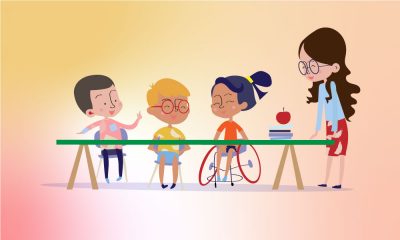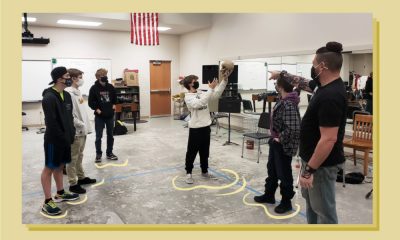Education
Are Art and Design Degrees Worth Pursuing Online?
Deferring a year or completing foundation credits early are some options.
While many believe that artistic ability is inherent in people, those who do practice art in any form will tell you that it is a skill that is honed and perfected over time. Commercial artists primarily fall in two categories: self-taught and trained. Although once seen as an unconventional career choice, today, certificate courses, undergraduate, postgraduate degrees, and other art education programs are gaining popularity. Graphic design, game design, multimedia art, interior design, and fashion design are some of the most popular concentrations.
Based on the major, there are numerous courses that rely on in-person instruction, specific software and require certain infrastructure. Educational institutions around the world have now been forced to move to an online model due to the COVID-19 pandemic. Educators and students are faced with the challenge of virtually carrying out courses such as textile design, animation, and painting while incoming art graduates ponder whether online courses are worth the expensive price tag.
With more institutions considering continuing online classes possibly till next year, we asked four people with diverse backgrounds in art to provide their insights on what next steps current and prospective students can consider.
Siddhant Talwar, arts students, Delhi


Talwar recommends completing foundation courses like theory during this time when access to equipment and studio space is limited. Photo courtesy: Siddhant Talwar
I’m pursuing my BFA in studio arts and BA in new media and society at Tufts University. The campus closed in March and I had to return to India. In my previous semester, I was taking several studio courses including directed study, darkroom [for photography] and digital fabrication.
When I’m thrown back home, facilities [like laser tools and the darkroom], networking opportunities, [in-person painting classes] aren’t available anymore.
For the next semester, I’ve chosen to stay virtual, the options for me are very basic, there’s no in-depth studio practice. The courses I’ve selected are all what I can make on my computer so if it’s fabrication, I’ve picked 3-D modeling, instead of doing print courses, I’ve gone back to graphic design. I’ve stopped myself from choosing things that I can’t physically do here. I came in with graphic designing and branched out, so [now] I can’t even explore what I was branching into.
If you’re planning to go to art school this year, maybe you could defer. You could wrap up your [foundation courses] like art history [and do studio courses] when you’re back on campus. Even taking a gap year of one year [won’t be held against you] if you want to consider it.
Madeeha Lamoreaux, adjunct lecturer, digital media design, Chicago
“The main issue I’m facing is the lack of equality and accessibility to software and hardware.”
The main issue I’m facing is the lack of equality and accessibility to software and hardware — this is a serious hindrance and highlights socioeconomic inequality among students. While there are some obvious differences, I don’t think the quality of education is affected by the online modality.
The virtual boundary isn’t as much of an issue for us since the work is mostly digital. I can see how this might be more of a problem for artwork that relies on physicality like sculpture or painting.
While deferring or dropping the semester is an individual decision, [my colleagues and I] are working as hard as we can to make things as smooth and accessible as possible. I don’t personally think that [dropping a semester] is wise, but again there might be specific home-life factors that hinder or distract a student from completing their coursework.
I would suggest continuing in online mode if possible; there is a lot of support coming from educators and institutions around this situation.
While [learning through tutorials and other platforms instead of going to art school] may be realistic and a great option for a few highly motivated individuals, I’ve found most of my students just cannot motivate themselves to learn on their own — especially now during a global pandemic.
Jugal Chudasama, illustrator, designer and entrepreneur, Mumbai


Not every artist needs art school but practicing skills is key. Photo courtesy: Jugal Chudasama
[In my teens], I did join [animation classes but dropped out] halfway through it. My dad’s sudden passing forced me to start working, so I started out at a desktop publishing place, began building my portfolio and a few months later, I started my first proper job designing t-shirts. Today…I run a design studio and work on freelance commissions.
Art school is important if you’re physically there, [virtually] it won’t make sense. If you feel you’ve found your style or you’re confident enough, you can take some time off and do freelance work. If you do take a semester or year off, continue working on your skills.
The pros [of learning on your own] are that you can create your own schedule, choose what you want to learn. The cons include getting no instant feedback, software is expensive, and not getting student discounts. Getting positive reinforcement will be difficult, so please show your work to your friends, even if it’s bad. It will be bad for a long time, so good luck with that.
Another thing missing in the digital college experience is building contacts. Have a website ready with your portfolio. Be prepared to work for yourself, because hiring has slowed down dramatically.
Jim Bond, sculptor, Yorkshire


Bond believes that art school is a worthwhile investment for the creative flexibility that it inculcates in students. Photo courtesy: Jim Bond
I think it would be an impoverished experience to only have online education, especially for the arts. In my field especially, with making, you have to be able to work with materials, equipment and technology.
For someone [interested in pursuing such courses], I would suggest that they defer for a year just because of the value and the amount of money that students are now spending.
Also read: The Trap Year: How Student Behaviour Post-COVID Will Impact Teachers
If students are taking time off and are looking to make the best use of it, as a sculptor, I would suggest going to visit sculpture parks and teaching yourself computer-aided design drawing software, which will make you much more employable and could also eventually help you with your degree.
I still think an arts degree is worth the investment…because you become very flexible and creative. You learn critical thinking and develop a vocabulary of the kind of art and design you’re interested in. There is a wide range of options, until you actually go, you won’t know which way you’re actually going to go.

























